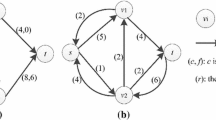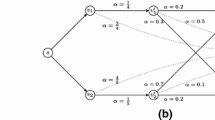Abstract
First, we present two classes of sequential algorithms for minimum flow problem: decreasing path algorithms and preflow algorithms. Then we describe another approach of the minimum flow problem, that consists of applying any maximum flow algorithm in a modified network. In section 5 we present several parallel preflow algorithms that solve the minimum flow problem. Finally, we present an application of the minimum flow problem.
Similar content being viewed by others
References
R. Ahuja, T. Magnanti and J. Orlin,Network Flows. Theory, al gorithms and applications, Prentice Hall, Inc, Englewood Cliffs, NJ, 1993.
R. Ahuja, T. Magnanti and J. Orlin,Some Recent Advances in Network Flows, SIAM Review33 (1990), 175–219.
R. Ahuja and J. Orlin,A Fast and Simple Algorithm for the Maximum Flow Problem, Operation Research37 (1988), 748–759.
R. Ahuja, J. Orlin and R. Tarjan,Improved Time Bounds for the Maximum Flow Problem. SIAM Journal of Computing18 (1988), 939–954.
A. V. Goldberg,Processor-efficient implementation of a maxim um flow algorithm, Information Processing Letters38 (1991), 179–185.
A. V. Goldberg,A New Max-Flow Algorithm, MIT, Cambridge, 1985.
A. V. Goldberg and R. E. Tarjan,A New Approach to the Maximum Flow Problem, Journal of ACM35 (1988), 921–940.
A. V. Goldberg and R. E. Tarjan,A Parallel Algorithm for Fin ding a Blocking Flow in an Acyclic Network, Information Processing Letters31 (1989), 265–271.
A. V. Karzanov,Determining the Maximum Flow in a Network by the Method of Preflows, Soviet. Math. Dokl.15 (1974), 434–437.
Y. Shiloach and U. Vishkin,An O (n 2 logn)parallel max-flow algorithm, J. Algorithms3 (1982) 128–146.
Author information
Authors and Affiliations
Corresponding author
Additional information
Dr. Eleonor Ciurea is a full professor at the “Transilvania” University of Bra§ov, Department of Computer Science. He has been an academic of this University for over 25 years. He is a member of the Scientists’ Associations of Romania, of the Society of Mathematical Sciences of Romania and of the American Mathematical Society. He also is a reviewer for the abstracting journals:Zentralblatt Fur Mathematik andMathematical Reviews. His field of research is algorithmic graphs (particularly dynamic network flow). He has published articles addressing the topic of dynamic flow in France, Belgium, USA, England, Korea etc.
Laura Ciupalâ is an assistant at the “Transilvania” University of Bra§ov, Department of Computer Science. Her field of research is theory of graphs (particularly network flows). S he has published articles addressing the topic of minimum flow in Moldavia and Romania.
Rights and permissions
About this article
Cite this article
Ciurea, E., Ciupalâ, L. Sequential and parallel algorithms for minimum flows. JAMC 15, 53–75 (2004). https://doi.org/10.1007/BF02935746
Received:
Revised:
Issue Date:
DOI: https://doi.org/10.1007/BF02935746




